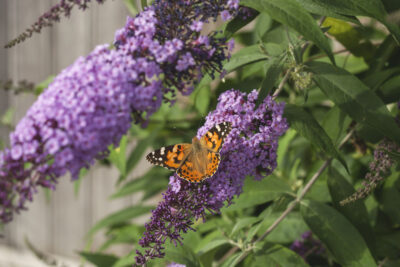
When done thoughtfully, it can become a powerful tool in the fight against species extinction. Many gardeners may not realize the impact their planting choices can have on local ecosystems, especially on endangered wildlife species. By selecting certain trees and shrubs, you can create a haven for these at-risk creatures, supporting their survival and fostering biodiversity right in your backyard.
Creating a Wildlife Haven: The Role of Trees and Shrubs
Trees and shrubs create a wildlife haven on your property, especially if you have the proper vegetation that will attract wildlife to your land. Specific trees and shrubs attract birds, bees, and even animals. If you’re interested in creating this ecosystem, it’s important to understand how certain trees and shrubs play a major role in doing so.
Monarch Butterflies and Milkweed
The monarch butterfly has orange and black wings and has seen a dramatic population decline due to habitat loss and pesticides. One of the most effective ways to help monarchs is by planting milkweed (Asclepias spp.), the sole host plant for monarch larvae. Milkweed provides nectar for adult butterflies and is the only plant where monarchs lay their eggs. By planting Milkweed, you’re helping these beautiful creatures to flourish.
Bees and Native Flowering Shrubs
Bees, play a vital role in pollination, but their numbers are declining due to pesticides, disease, and habitat loss. Planting native flowering shrubs such as elderberry (Sambucus canadensis), spicebush (Lindera benzoin), and buttonbush (Cephalanthus occidentalis) can provide essential nectar and pollen sources. These shrubs not only support bees but also enhance the overall health of your garden by promoting pollination.
Birds and Berry-Producing Trees
Many bird species, including the endangered Kirtland’s warbler, rely on specific trees and shrubs for food and nesting. Berry-producing trees and shrubs such as serviceberry (Amelanchier spp.), elderberry (Sambucus spp.), and dogwood (Cornus spp.) provide vital nourishment. These plants offer high-energy fruits that sustain birds through migration and breeding seasons. Additionally, dense shrubs like the American hazelnut (Corylus americana) provide excellent nesting sites and cover.
Mammals and Nut-Bearing Trees
Small mammals, such as the endangered Indiana bat, benefit greatly from nut-bearing trees like oaks (Quercus spp.) and hickories (Carya spp.). These trees produce acorns and nuts that are essential food sources for bats and other wildlife. Furthermore, the cavities in mature trees offer roosting sites for bats, which are crucial for their survival. Planting a mix of nut-bearing trees can create a sustainable food supply and habitat for these important mammals.
Benefits of Using Trees and Shrubs Specific for Endangered Species
Using specific trees and shrubs to create a healthy ecosystem for endangered species is a noble and beautiful act. There are plenty of benefits of doing so, which can be rewarding for you and your property.
Here are some of the benefits:
- Source of food and shelter for wildlife
- Haven for endangered species
- Helps to create a beautiful landscape.
- Increasing in nesting for birds
- Better overall health for the natural environments
Why Choose Cold Stream Farm for Trees and Shrubs at Wholesale in Michigan?
At Cold Stream Farm, we provide trees and shrubs for wholesale at our farm in Michigan. We’re in the business of supporting the native species and vegetation here in Michigan, and we encourage you to do the same. If you’re looking for planting tips or looking to buy trees and shrubs to help the endangered species, come back and thrive in your community, don’t hesitate to reach out to us.
Contact Cold Stream Farm at (231) 464-5809 today or visit us online for more information!

